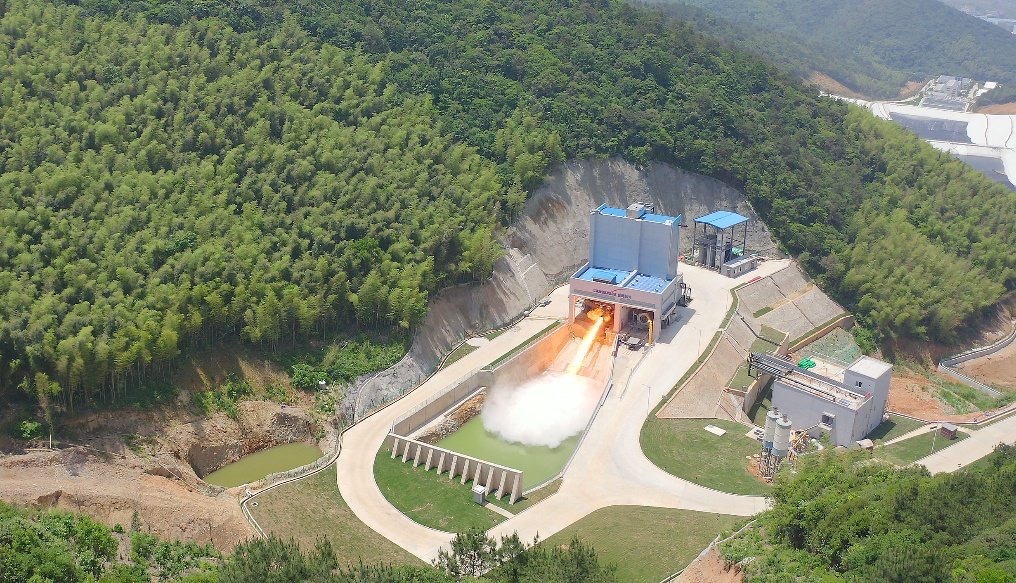29.11.2023

Aerial view of Chinese private launch firm Landspace testing its Tianque-12 methalox engine at a facility in Huzhou. Credit: Landspace
HELSINKI — China is progressing with a program to develop full-flow staged-combustion-cycle methane engines to power its reusable Long March 9 super heavy-lift launcher.
Work to develop full-flow staged-combustion-cycle methane-liquid oxygen rocket engines producing 200 tons of thrust includes progress on overall design and components.
Testing includes firing prototype and scaled components such as igniters, gas generators and thrust chambers.
Authors belonging to the Xi’an Aerospace Propulsion Institute outline the progress made by China on these and other methane-liquid oxygen engines in a recent article. The institute is the major liquid propulsion rocket engine design unit under CASC.
Clusters of 26 of the reusable engines will power the first stage of China’s Long March 9 super heavy-lift launcher, according to designs presented earlier by officials from the China Aerospace Science and Technology Corp. (CASC), China’s main space contractor. CASC is understood to be targeting 2033 for a first test flight on the massive rocket.
The paper notes research began in China in the 1980s and that 10-ton and 80-ton-thrust methalox engines have now been developed. The latter have undergone successful hot fire tests and mark advancements in engine reliability and reusability.
The development of the full-flow staged-combustion-cycle methalox engines will support China’s plans for future large-scale deep space exploration, including a Mars landing and other objectives.
The paper states that core indicators make the engine comparable to the SpaceX Raptor engine that powers Super Heavy/Starship. As the world’s second full-flow staged-combustion-cycle methalox engine it is superior to Blue Origin’s BE-4 and other domestic and international methane engines, the paper claims. The latter engines have a higher thrust, however.
The authors note challenges ahead however. Full-flow staged-combustion-cycle engines can provide high-thrust and high efficiency, as well as benefits in terms of reliability and reusability. But challenges include complex system configuration, difficulties in integrated layout and final assembly, and controlling the ignition process.
They also state that the country’s foundations for fully developing these engines remains relatively weak. Efforts in related technologies, they say, need to be strengthened to complete the complex and technically difficult project. The goal of low cost, highly reliable and rapidly reusable engines is however seen as key to national objectives. It would become an iconic technology and a leapfrog advance for China’ space sector, according to the article.
The paper also highlights progress on methalox engines made by Chinese commercial entities. Noted are the Mingfeng-1 engine developed by CASIC, Landspace’s Tianque engines which power the Zhuque-2 and the variable thrust JD-1/Focus-1 engine for iSpace’s reusable Hyperbola rocket series. Longyun engines developed by engine maker Jiuzhou Yunjian, and Aerospace Propulsion’s Canglong engines are also listed.
Landspace, one of the earliest firms to emerge after China opened up the space sector to private capital, operates Zhuque-2 the first and so far only methalox rocket to reach orbit. The startup is now also planning a stainless steel methalox rocket. Named Zhuque-3, it will be capable of sending 20 tons to low Earth orbit when expendable, or 16.5 tons reusable.
Meanwhile another early mover, iSpace, recently performed a hop test with a test stage for its methalox Hyperbola rockets. It plans to follow up with a kilometer-level test in the near future.
The breakthroughs in methane engines within China—as well as the progress in the United States, and SpaceX’s demonstration of reusability—have led to a change in long-term direction of China’s space transportation plans.
The Long March 9 super heavy-lift rocket was, according to plans going back to 2011, to be powered by 500-ton-thrust kerosene-liquid oxygen engines. These engines are at a much more advanced stage of testing. They would however be the basis of an expendable launch system.
Newer designs presented in 2022 and 2023 show a Long March 9 design using methalox engines with no boosters. One more distant variant resembles the Super Heavy/Starship stack.
China is also developing a three-stage heavy-lift rocket specifically to send Chinese astronauts to the moon by 2030. That rocket will be powered by upgraded kerolox engines based on the Long March 5. The first stage of that and a two-stage LEO version will potentially be recoverable and reusable.
Quelle: SN

